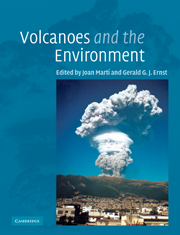Book contents
- Frontmatter
- Contents
- List of contributors
- Preface
- Acknowledgments
- Chapter 1 Understanding the physical behavior of volcanoes
- Chapter 2 Volcano hazards
- Chapter 3 Anticipating volcanic eruptions
- Chapter 4 Volcanoes and the geological cycle
- Chapter 5 Effects of volcanic eruptions on the atmosphere and climate
- Chapter 6 Volcanoes, hydrothermal venting, and the origin of life
- Chapter 7 Volcanism and mass extinctions
- Chapter 8 Effects of modern volcanic eruptions on vegetation
- Chapter 9 Animals and volcanoes: survival and revival
- Chapter 10 Human impacts of volcanoes
- Chapter 11 Volcanoes, geothermal energy, and the environment
- Chapter 12 Volcano-hosted ore deposits
- Chapter 13 Industrial uses of volcanic materials
- Chapter 14 Volcanoes, society, and culture
- Chapter 15 Volcanoes and the economy
- Index
- References
Chapter 11 - Volcanoes, geothermal energy, and the environment
Published online by Cambridge University Press: 14 November 2009
- Frontmatter
- Contents
- List of contributors
- Preface
- Acknowledgments
- Chapter 1 Understanding the physical behavior of volcanoes
- Chapter 2 Volcano hazards
- Chapter 3 Anticipating volcanic eruptions
- Chapter 4 Volcanoes and the geological cycle
- Chapter 5 Effects of volcanic eruptions on the atmosphere and climate
- Chapter 6 Volcanoes, hydrothermal venting, and the origin of life
- Chapter 7 Volcanism and mass extinctions
- Chapter 8 Effects of modern volcanic eruptions on vegetation
- Chapter 9 Animals and volcanoes: survival and revival
- Chapter 10 Human impacts of volcanoes
- Chapter 11 Volcanoes, geothermal energy, and the environment
- Chapter 12 Volcano-hosted ore deposits
- Chapter 13 Industrial uses of volcanic materials
- Chapter 14 Volcanoes, society, and culture
- Chapter 15 Volcanoes and the economy
- Index
- References
Summary
Introduction
Volcanoes and volcanism in all forms produce a variety of impacts on the environment. Some impacts are desirable, for example the eye-pleasing shape of a majestic volcanic edifice outlined across a horizon and the sight of bountiful crops growing in rich soil developed on volcanic ash. Others, however, are detrimental; no one is pleased when a volcanic eruption damages or destroys humans or works of humans. Depending on volume, chemical composition, and explosivity, the detrimental impacts of an eruption can range in aerial extent from local to global.
An indirect but substantial impact on the environment occurs through a link between volcanism (and its associated magmatism) and a resultant partial redistribution of Earth's internal thermal energy into concentrations that are resources for potential human consumption (Duffield and Sass, 2003). Over broad regions of the Earth, temperature increases almost monotonically downward in the crust beneath a few-meters-thick zone that responds to annual temperature fluctuations. Outside of volcanically active regions, this global background thermal condition of the crust is characterized by a conduction-dominated geotherm in the range of 10–50 °C/km. However, when magma enters the crust, for example, as a shallow intrusion beneath a volcano, this background condition is perturbed locally as temperature rises around the intrusion. The amplitude, volume, and longevity of such a thermal anomaly depend mostly on the temperature and volume of the intruded melt.
- Type
- Chapter
- Information
- Volcanoes and the Environment , pp. 304 - 332Publisher: Cambridge University PressPrint publication year: 2005
References
- 2
- Cited by



